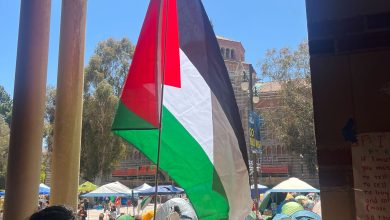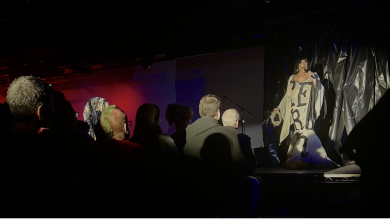Remnants: Embodied Archives of the Armenian Genocide: Book Talk With Dr. Elyse Semerdjian

Photo taken by Isabel Kate Colburn
Image Description: A computer displaying an ongoing Zoom video call, with a mug sitting beside the computer.
On the morning of November 15, communicating with a sea of faces perched neatly within miniscule Zoom rectangles, Dr. Elyse Semerdjian asserted a startling, but apt, comparison. “To be invested in genocide prevention today feels very much like being a believer in unicorns,” the distinguished professor, author, and social historian said. “Perhaps I’m an idealist who believes in unicorns.”
In an event organized by The Armenian Genocide Research Program of the Promise Armenian Institute at UCLA, Semerdjian presented her newest book, Remnants: Embodied Archives of the Armenian Genocide. Published by Stanford Press in 2023, Remnants uncovers the gendered nature of genocide, preserving the historical horrors that Armenian women and girls faced at the hands of Ottoman Turkish forces during the early twentieth century. However, this book is not Semerdjian’s first, or only, accomplishment in the field of genocide studies. In 2008, she published her book, “Off the Straight Path”: Illicit Sex, Law, and Community in Ottoman Aleppo. She currently works at the German University of Erfurt, where she further researches the history of Armenian communities in Aleppo, Syria.
Historical context is important in fully understanding Semerdjian’s work.Tensions between Christian Armenians and Muslim Ottoman Turks heightened in the Ottoman Empire during the early twentieth century, when the Turkish government raised alarm about Armenians potentially achieving further social and political power. With the beginning of World War I, the Turkish government also feared that Armenians would aid enemy troops upon invasion. At the root of these tensions was the violent, racist desire to eliminate an entire ethnic group. In 1915, the Turkish government initiated the forced removal of Armenians from their homes in an aggressive “relocation” program, both deporting and sending Armenians to concentration camps. Deliberate massacres of Armenians by the Turkish government also began at this time, while many others died in captivity due to starvation, illness, and exhaustion. Ultimately, around 1.5 million Armenians lost their lives.
The United Nations General Assembly identifies genocide as a clear crime under international law in Article II of the 1948 Convention on the Prevention and Punishment of the Crime of Genocide. Article II specifically defines genocide as “any of the following acts committed with intent to destroy, in whole or in part, a national, ethnical, racial or religious group,” with these referenced acts including killing, mentally torturing, or relocating the children of this particular group. While the nature of the atrocities committed against Armenians are undeniably genocidal in nature, the Turkish government remains in steadfast denial. Since 1915, Armenians have fought for both the acknowledgement of this reality, as well as reparations for this attempted annihilation.
Opening her book talk, Semerdjian spoke on the complexity of studying the intersections between gender and genocide with the current system of traditional archives used by historians. Specifically, she elaborated on the state “cleansing” of historical archives, or the purposeful exclusion of marginalized voices by governments. This creates a lack of research on and preservation of the historical experiences of women and girls, especially surrounding harrowing topics like sexual assault and forced marriages. Furthermore, survivors are often reluctant to publicize their stories, as sharing them requires such vulnerability and intimacy. Thus, the sensitivity of these topics elicits avoidance from survivors, as sharing these experiences unearths deeply painful memories. Ultimately, Semerdjian recognized the erasure of Armenian women’s survival stories, emphasizing the gaps in history she remained unable to fill.
Further, Semerdjian acknowledged the delicate nature of these histories while highlighting the importance of recording them. Survivors often feel reluctant to publicize their experiences, as sharing them requires such vulnerability and intimacy. Thus, the sensitivity of these topics elicits avoidance, as recounting these stories unearths deeply painful memories for survivors. With Remnants, Semerdjian hoped to “attend to this silence by thinking through and with the materiality of the gendered body as an archive of genocide experience that communicates affective knowledge.” In other words, the bodies of these women hold invaluable histories, and studying them allows a greater insight into how gender alters the way one experiences genocide.
Semerdjian continued the talk by describing the experiences unique to Armenian women and girls during this time. She explained that women were abducted from their Armenian families and communities, forced to assimilate into Muslim Turkish households. Here, they converted to Islam and often married Turkish men against their will.
She elaborated further, expounding on the way in which Turkish men used sex as a volatile weapon that stripped women of any societal power. At the hands of these men, Armenian women experienced rape, forced birth, and other sexual abuse. With these examples, Semerdjian encouraged listeners to consider how the objectification of the female body works in the context of genocide. As Turkish men controlled and violated Armenian women, they sent a clear signal of strength, possession, and dominance to Armenian men. In this way, sexual violence can take the form of patriarchal communication, a sort of non-verbal messaging of supremacy between male groups.
Continuing her discussion, Semerdjian presented a photo of a young woman named Miriam Azarian, who stood in a provocative pose and bore tattoos around her face, chest, and breasts. These tattoos hold several hypothesized meanings, possibly representing the tree of life, figures in the afterlife, or flowers. In this way, these tattoos hold inherent irony: at the same time they may exhibit thematic ideas of beauty, they aid in the violation and subjugation of Armenian women. Upon displaying the image, Semerdjian invited listeners to express the emotions the tattoos invoked within them. While some participants typed the words “sexual mistreatment,” or “visceral pain,” another conveyed the following chilling sentiment: “my throat has tightened.”
Semerdjian detailed the way tattooing was used as a branding tool for Armenian women during this genocide, indicating which Turkish households these women assimilated into. The tattoos immediately created a sense of otherness, symbolizing displacement from home and highlighting the trauma endured. The tattoos also reduced a woman to a sexual object, as they often accentuated a woman’s chest and breasts.
Semerdjian, following this, invited listeners to consider how women endure exploitation in the documentation and recording of genocide. Quoting Algerian writer Malek Alloula, she described what is known as “ethnographic alibi,” or the idea that the goal of authentically capturing a group’s struggle condones exploitation and privacy violation. Women often experience this violation most acutely, as photos of their naked bodies become objectified and disrespected in the name of historical preservation. We see this through the provocative pose in which the young Miriam Azarian stands.
To counteract this type of photography, which dehumanizes individuals and sensationalizes pornographic elements under the guise of truth-seeking, Semerdjian suggested a critical engagement with photography capturing genocide. Rather than passively accepting these photos, one may view them in community, collaborating with others to fill in what is missing.
Semerdjian concluded her talk by accepting inquiries from listeners. Questions ranged from the exploitative nature of humanitarian campaigns, the significance of looking at photos in community, and the feminization of tattooing during this time. Ultimately, she emphasized how the territorialization and sexual violation of Armenian women’s bodies by the Turkish aided in the accomplishment of this atrocity against the Armenian people.
Semerdjian’s book talk about the horrors of genocide occurred at a poignant time in history, as the world currently watches yet another genocide taking place towards the Palestinian people. After the October 7th massacre of around 1,200 Israelis by the Palestinian Sunni Islamist organization, Hamas, Israel’s violent response in Gaza has incited a Palestinian genocide. At the time of Semerdjian’s book talk, Israel’s bombings had claimed around 12,000 Palestinian lives. Almost one third of these were children.
Engaging with Semerdjian’s book talk today feels dystopian. At the same time she academically discusses the gendered consequences of genocide, innocent people are experiencing these realities. Is calling for genocide prevention truly akin to believing in unicorns?
As we ask ourselves this question, we can engage with the words uttered by Semerdjian herself, who dedicates her work each day to further genocide education and prevention: “The world simply seems unwilling to apply the rules that were created in the aftermath of two world wars, two genocides…I think that’s why it’s even more important for us as historians to educate the public about why those rules were created in the first place and why they might be worth saving.”




